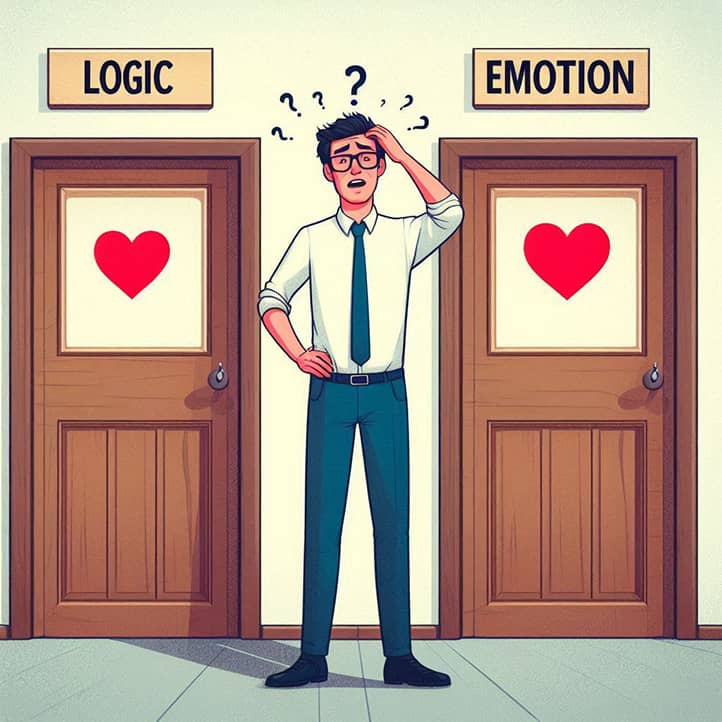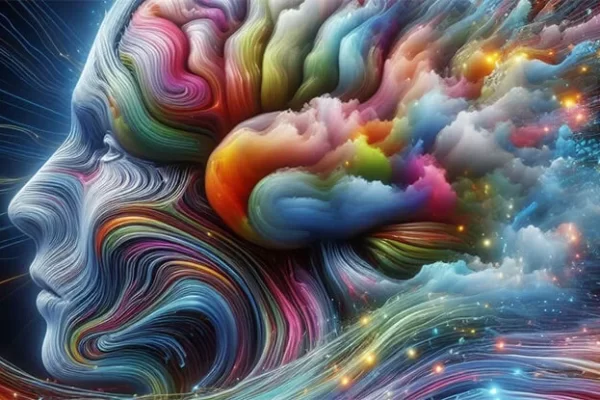In a world where information is available at our fingertips, and opinions and beliefs are formed and changed at lightning speed, understanding the mechanisms of our thinking becomes the key to a conscious life. One of these mechanisms is cognitive dissonance—a phenomenon that largely shapes our perception of reality and decision-making. Let’s dive deeper into this topic and examine how cognitive dissonance affects our daily lives and shapes our worldview.
Basics of the Theory of Cognitive Dissonance
The human mind can process vast amounts of information and form complex concepts. However, like any tool, it has its peculiarities and limitations. One of these is the drive for internal consistency, which is at the heart of cognitive dissonance theory.
Imagine you’re putting together a puzzle, where each piece represents a belief or experience. When all the pieces fit smoothly, you feel satisfaction and peace. But what happens when you find a piece that doesn’t fit anywhere? This moment of confusion and discomfort is the essence of cognitive dissonance.
Our brain, when faced with contradictions, doesn’t remain a passive observer. It actively seeks ways to resolve the conflict, whether through reassessing existing information, searching for new data, or even ignoring inconvenient facts. This process is not always conscious, but it constantly influences our perception of the world and our decision-making.
Cognitive dissonance theory offers a unique perspective on the workings of the human mind, explaining many seemingly irrational aspects of our behavior. It helps explain why we sometimes stubbornly cling to beliefs even in the face of contradictory evidence and how this mechanism influences the formation of our personality and worldview.

What is Cognitive Dissonance?
Simply put, cognitive dissonance is a state of psychological discomfort that arises when a person encounters conflicting ideas, beliefs, values, or emotional responses. This term was introduced by American psychologist Leon Festinger in 1957 and has since become one of the key concepts in social psychology.
Festinger developed the theory of cognitive dissonance based on observations of a religious group that believed in an imminent apocalypse. When the predicted date passed and the world remained intact, instead of admitting the error of their beliefs, the group members strengthened their faith even further. This paradoxical behavior formed the basis of cognitive dissonance theory.
Key Components of Cognitive Dissonance
- Inconsistency. Presence of conflicting beliefs, attitudes, or behaviors.
- Discomfort. Psychological tension caused by this inconsistency.
- Motivation. Desire to reduce or eliminate the discomfort.
Mechanism of Occurrence
Cognitive dissonance occurs when a person encounters information or experiences that contradict their existing beliefs or values. For example, a smoker, knowing the health risks of smoking, continues to smoke. This creates an internal conflict between knowledge of smoking’s harms and actual behavior.
Psychological and Physiological Manifestations
Cognitive dissonance can manifest as:
- Anxiety or worry.
- Feelings of discomfort or tension.
- Indecisiveness or confusion.
- Physical symptoms, such as increased heart rate or sweating.

Impact of Cognitive Dissonance on Worldview
Our worldview is a complex, multifaceted picture composed of numerous elements: personal experience, cultural context, education, and more. Cognitive dissonance acts as an invisible architect of this picture, constantly adjusting and restructuring its elements.
Imagine your worldview as a map of an unknown territory, which you are constantly updating and refining. In this analogy, cognitive dissonance acts as a compass pointing to areas of inconsistency and contradiction. It prompts us to either revise our “map” or find ways to explain these inconsistencies, maintaining the integrity of our vision of the world.
This continuous “mapping” of reality has profound consequences for our interaction with the surrounding world. It affects how we interpret new information, form relationships with others, and even perceive ourselves. Cognitive dissonance can foster personal growth by encouraging us to re-evaluate outdated beliefs, or it can create barriers to new ideas if we are too attached to existing views.
In social interactions, cognitive dissonance often acts as a hidden factor influencing group dynamics and interpersonal relationships. It can enhance group cohesion when members share common beliefs but can also lead to conflicts and misunderstandings when opposing views collide.
Formation of Beliefs and Values
Cognitive dissonance plays a significant role in shaping and maintaining our beliefs and values. When we encounter information that contradicts our established views, we tend to:
- Ignore or devalue this information.
- Seek confirmation of our beliefs.
- Rationalize our actions or beliefs.
This process helps us maintain the integrity of our worldview but can also hinder personal growth and adaptation to new realities.
Impact on Decision-Making
Cognitive dissonance significantly affects decision-making processes:
- Choice confirmation. After making a decision, we tend to seek information that confirms the correctness of our choice and ignore contradictory data.
- Avoiding regret. We may rationalize even poor decisions to avoid feelings of regret or admitting mistakes.
- Commitment escalation. Sometimes we continue to invest time, money, or effort into a project even when it becomes clear that it is unsuccessful, to justify prior investments.
Role in Social Interactions
Cognitive dissonance affects our relationships with others:
- Group formation. We tend to associate with people who share our beliefs to minimize dissonance.
- Confirmation bias. In communication, we often seek confirmation of our views, which can lead to opinion polarization.
- Stereotyping. Cognitive dissonance can reinforce stereotypes, as they simplify our worldview and reduce conflicting information.

Examples of Cognitive Dissonance in Daily Life
Cognitive dissonance is not just an abstract psychological concept but a living phenomenon that we encounter daily, often without realizing it. It manifests in a variety of situations, from trivial everyday choices to serious life decisions.
Imagine cognitive dissonance as an invisible companion that accompanies us in everyday life, constantly pushing us toward reflection and reassessment of our actions and beliefs. Its presence can be seen in moments of doubt when buying an expensive item, in justifications we find for unhealthy habits, or in complex emotions arising from the discrepancy between our ideals and real actions.
In professional settings, cognitive dissonance may arise when our personal values conflict with corporate culture or job requirements. This can cause internal conflict and stress, prompting us to either adapt our views or seek ways to change the situation.
In personal relationships, cognitive dissonance often occurs when we encounter behavior in close people that does not align with our expectations or views about them. This may lead to re-evaluation of relationships, search for justification, or even changing our beliefs about the nature of relationships and human behavior.
In personal relationships
- Romantic relationships. A person may ignore negative traits of a partner to justify their choice or continuation of the relationship.
- Family conflicts. A parent may justify strict discipline for a child despite knowing the negative effects of such an approach.
- Friendship. We may continue to associate with people whose behavior we dislike, rationalizing it with the length of the friendship or shared memories.
In professional settings
- Career choice. A person may convince themselves of the correctness of their career choice, even if it does not bring satisfaction, to justify years of study and work.
- Corporate ethics. An employee may ignore unethical company practices to maintain their job and a positive image of their employer.
- Professional burnout. A specialist may deny signs of burnout, believing fatigue and stress are normal in their profession.
In consumer behavior
- Purchasing expensive goods. After buying an expensive item, a person may exaggerate its benefits and ignore flaws to justify the expense.
- Brand loyalty. A consumer may continue buying products of a particular brand even if quality declines, to support their choice and identity.
- Impulse purchases. People often rationalize unnecessary purchases by finding uses for them or convincing themselves of their necessity.

Strategies for Overcoming Cognitive Dissonance
Overcoming cognitive dissonance is not just a psychological process; it is a kind of art in balancing between preserving personal integrity and embracing change. This skill requires awareness, mental flexibility, and a willingness to engage in self-reflection.
Imagine that your mind is a complex musical instrument, and cognitive dissonance is a dissonant chord. The goal is not to completely eliminate dissonance but to learn to incorporate it as part of a more complex and rich melody of your thoughts.
One of the key strategies in addressing cognitive dissonance is to develop metacognitive skills—skills that enable you to observe and analyze your own thinking processes. This allows you to more objectively assess your beliefs and their origins, as well as recognize moments when you may distort reality to maintain a state of comfort.
It’s also essential to cultivate openness to new experiences and information, even when they contradict existing views. This doesn’t mean uncritical acceptance of all new ideas; rather, it involves a readiness to consider alternative perspectives and reassess beliefs in light of new data. This approach not only helps in managing cognitive dissonance but also promotes personal growth and the development of critical thinking.
Changing Behavior
One way to reduce cognitive dissonance is to change behavior to align with beliefs. For example:
- A smoker may quit smoking, bringing their behavior in line with the knowledge of smoking’s harm.
- Someone who values environmental conservation may start sorting waste and using eco-friendly products.
Changing Beliefs
Sometimes it’s easier to change beliefs than behavior:
- A student with a low grade may convince themselves that grades aren’t crucial to future success.
- A person who didn’t keep a promise may rethink the importance of their word in specific situations.
Seeking New Information
An often effective way to resolve cognitive dissonance is to seek additional information:
- Exploring various viewpoints on an issue can help in forming a more balanced opinion.
- Consulting experts or examining scientific research can provide new facts to reassess the situation.

Positive and Negative Aspects of Cognitive Dissonance
Like many psychological phenomena, cognitive dissonance cannot be categorically classified as positive or negative. Its role in our mental life is multifaceted and depends on context and our approach to it.
On one hand, cognitive dissonance can be seen as a kind of psychological defense mechanism, helping us maintain personal integrity and positive self-esteem. It can motivate us toward positive changes when we strive to align our behavior with our values, or it can prompt a deeper analysis and understanding of complex situations.
However, an excessive drive to resolve cognitive dissonance can lead to reality distortion, ignoring important information, or rationalizing unethical behavior. This is especially noticeable when people hold onto harmful habits or stay in toxic relationships, finding justifications for their actions.
Interestingly, in some fields, such as science or art, the ability to handle cognitive dissonance can be a key to creativity and innovation. The capacity to hold conflicting ideas in mind without immediately resolving them can lead to unexpected insights and discoveries.
Potential for Personal Growth
Cognitive dissonance, despite the discomfort it causes, can be a powerful stimulus for personal growth:
- Stimulus for learning. Discomfort from conflicting information may motivate us to seek new knowledge and broaden our horizons.
- Reevaluation of beliefs. Facing contradictions can prompt us to reconsider and improve our beliefs and values.
- Development of critical thinking. The need to resolve cognitive conflicts develops skills in analyzing and evaluating information.
- Increased self-awareness. Awareness and analysis of one’s cognitive processes lead to a deeper understanding of oneself.
Risks of Ignoring or Mismanaging Dissonance
However, if cognitive dissonance is not managed properly, it can lead to various negative consequences:
- Strengthening false beliefs. To avoid discomfort, a person may further reinforce erroneous views.
- Denial of reality. Ignoring conflicting information can lead to a distorted perception of reality.
- Reduced adaptability. Inability to accept new information may make it challenging to adapt to changing circumstances.
- Emotional stress. Constant suppression or ignoring of cognitive dissonance may lead to chronic stress and anxiety.
- Interpersonal conflicts. The inability to accept a viewpoint different from one’s own can complicate relationships with others.

Cognitive Dissonance in the Modern Information Society
In the age of information abundance and digital technologies, cognitive dissonance takes on new forms and scales. We encounter a vast flow of diverse, often contradictory information daily, creating fertile ground for cognitive conflicts.
Social networks and content personalization algorithms create a unique environment where our beliefs can simultaneously be reinforced and challenged. On the one hand, we tend to surround ourselves with information that confirms our views, which can reinforce existing beliefs and biases. On the other hand, inevitable encounters with alternative perspectives can provoke acute cognitive dissonance.
In the context of global issues like climate change or pandemics, cognitive dissonance can play a critical role in shaping public opinion and behavior. The complexity and scale of these problems often conflict with our everyday habits and short-term interests, creating tension between the awareness of the need for change and the desire to maintain our usual way of life.
Notably, the very nature of modern communication technologies can amplify the effects of cognitive dissonance. Instant access to information and the ability to express opinions immediately can lead to faster and more intense cycles of forming and resolving cognitive conflicts, presenting new challenges for our ability to reflect and engage in thoughtful analysis.
Influence of Social Media
Social networks and online platforms play a significant role in the formation and intensification of cognitive dissonance:
- Information overload. The vast flow of information makes it difficult to critically evaluate it, potentially amplifying cognitive distortions.
- Echo chambers. Social media algorithms often display content that aligns with users’ views, which can reinforce existing beliefs and create an illusion of their universality.
- Rapid spread of misinformation. False information can spread faster than its correction, providing fertile ground for cognitive dissonance.
- Social pressure. The desire to align with group opinions on social media can intensify cognitive dissonance when faced with contradictory information.
Role in Creating “Information Bubbles”
Cognitive dissonance contributes to the creation and strengthening of “information bubbles”:
- Selective perception. People tend to focus on information that supports their beliefs and ignore conflicting information.
- Confirmation bias. Recommendation algorithms on social networks and search engines amplify this effect by offering content that aligns with the user’s previous interests.
- Polarization of opinions. “Information bubbles” can lead to strengthening extreme views and hinder dialogue between people with differing beliefs.
The Importance of Critical Thinking
In an era of information saturation, critical thinking becomes a key skill for managing cognitive dissonance:
- Source evaluation. The ability to distinguish between reliable and unreliable sources of information helps reduce the risk of forming false beliefs.
- Argument analysis. Skills in critically analyzing arguments allow a more objective assessment of conflicting information.
- Openness to new ideas. Developing the ability to consider alternative perspectives helps reduce cognitive dissonance and broadens horizons.
- Metacognitive skills. The ability to analyze one’s thinking processes allows for a better understanding and control of cognitive dissonance.
- Emotional intelligence. Developing the ability to recognize and manage emotions helps more effectively cope with the discomfort caused by cognitive dissonance.

Practical Strategies for Managing Cognitive Dissonance
Managing cognitive dissonance isn’t just a theoretical concept; it’s a practical skill that can be developed and honed. This skill is becoming increasingly important in the modern world, where we constantly encounter conflicting information and complex ethical dilemmas.
One effective strategy is cultivating “epistemic humility,” which involves recognizing the limitations of one’s own knowledge and being open to revising it. This doesn’t mean abandoning beliefs but adopting a more flexible and open approach to new information. Practicing regular reflection and analysis of personal beliefs can help identify areas where cognitive dissonance is likely to arise.
Developing critical thinking and media literacy skills also plays a key role in managing cognitive dissonance. Being able to analyze sources, recognize logical fallacies, and identify biases in arguments helps in evaluating conflicting information more objectively and making balanced decisions.
An interesting approach is practicing “intellectual empathy”—attempting to understand and accept a perspective opposite to one’s own. This exercise not only helps reduce cognitive dissonance but also fosters a more detailed and complex understanding of difficult issues.
Awareness and Acknowledgment
The first step in managing cognitive dissonance is to recognize and acknowledge it:
- Self-observation: Regularly analyze your thoughts and feelings, especially in situations that cause discomfort or tension.
- Acknowledging contradictions: Rather than ignoring or denying contradictions, recognize their existence.
- Accepting discomfort: Remember that feeling discomfort when faced with conflicting information is a normal reaction, not a sign of weakness.
Actively Seeking Information
Expanding knowledge helps resolve cognitive dissonance:
- Diversifying sources: Try to gather information from a range of sources, including those that might contradict your beliefs.
- Exploring opposing viewpoints: Intentionally seek out arguments that challenge your position to gain a fuller understanding of the issue.
- Fact-checking: Use reliable resources to verify information, especially if it provokes a strong emotional reaction.
Re-evaluating Beliefs
Sometimes the most effective way to resolve cognitive dissonance is to reassess personal beliefs:
- Flexible thinking: Develop the ability to change your views when new information arises.
- Gradual approach: Instead of abandoning a belief entirely, consider modifying or refining it.
- Integrating new ideas: Find ways to incorporate new information into your existing belief system, creating a more nuanced and detailed worldview.
Accepting Uncertainty
The ability to live with uncertainty and contradictions is essential in managing cognitive dissonance:
- Tolerance for ambivalence: Develop the capacity to accept the coexistence of conflicting ideas or feelings.
- Avoiding dichotomous thinking: Steer clear of black-and-white judgments by acknowledging the complexity and multifaceted nature of most phenomena.
- Accepting the limits of knowledge: Remember that it’s impossible to know everything, and there is always room for new discoveries and changes in perspective.

Cognitive Dissonance in Different Life Areas
Cognitive dissonance manifests in all aspects of human activity, but its impact and consequences can vary greatly depending on the context. In education, for example, cognitive dissonance can be a powerful catalyst for learning, encouraging students to reassess previous ideas and integrate new knowledge.
In business and management, cognitive dissonance can play a dual role. On the one hand, it can stimulate innovation and creative thinking, pushing leaders and teams to seek unconventional solutions when faced with conflicting market demands. On the other hand, an excessive drive to resolve cognitive dissonance can lead to groupthink and overlooking important signs of the need for change.
In politics and public relations, cognitive dissonance often underlies ideological conflicts and social polarization. Understanding cognitive dissonance mechanisms can aid in developing more effective communication strategies and finding compromises between different interest groups.
In healthcare and the promotion of healthy lifestyles, cognitive dissonance is particularly important. It can act as a barrier to changing harmful habits but also as a motivator to adopt healthier behaviors when individuals strive to align their actions with health and wellness values.
In Education
Cognitive dissonance plays an important role in the learning process:
- Conceptual changes: Encountering new ideas that contradict existing knowledge can stimulate deep learning and lead to concept revision.
- Motivation for learning: The desire to resolve cognitive dissonance can motivate students to actively seek information and engage in self-education.
- Overcoming biases: Recognizing cognitive dissonance can help students and teachers identify and overcome prejudices in the learning process.
In Politics and Public Life
Cognitive dissonance significantly influences political views and public opinion:
- Political polarization: The urge to avoid cognitive dissonance can deepen societal divides, creating opposing groups.
- Persistence of political beliefs: Even when confronted with contradictory facts, people often cling to political views to avoid dissonance.
- News perception: Cognitive dissonance affects how people interpret news and form opinions on current events.
In Science and Innovation
Paradoxically, cognitive dissonance can both hinder and drive scientific progress:
- Resistance to new theories: Scientists may experience cognitive dissonance when confronted with data that contradict established theories, which can slow the acceptance of new ideas.
- Incentive for research: The desire to resolve contradictions can motivate scientists to conduct new experiments and develop innovative theories.
- Interdisciplinary discoveries: Overcoming cognitive dissonance when working at the intersection of various fields of knowledge can lead to breakthrough discoveries.

Conclusion
Cognitive dissonance is a fundamental aspect of the human psyche, playing a key role in shaping our worldview and behavior. This phenomenon permeates all areas of our lives, from everyday decisions to global issues in society and science. Understanding the mechanisms of cognitive dissonance opens new perspectives on self-awareness and personal growth.
In today’s world, characterized by an abundance of information and rapid changes, the ability to manage cognitive dissonance effectively is a critically important skill. This skill allows us to adapt more flexibly to new realities while maintaining personal integrity and critical thinking. Developing “epistemic humility,” media literacy, and reflection skills helps us not only cope with internal contradictions but also use them as a source of growth and development.
It’s essential to remember that cognitive dissonance isn’t just a psychological phenomenon; it’s an integral part of the process of understanding the world and oneself. It may be a source of discomfort but also a driver of positive change. Balancing resilience in one’s beliefs with openness to new experiences is an art that can and should be cultivated.
In the context of social and global issues, understanding the role of cognitive dissonance can contribute to more effective dialogue between different groups and the search for constructive solutions. This is especially relevant in an era when society faces complex challenges that require cooperation and mutual understanding.
Research on cognitive dissonance continues to uncover new dimensions of this phenomenon and its influence on individual and collective behavior. Future studies in this area may lead to the development of more effective strategies for learning, decision-making, and conflict resolution. They may also shed light on how cognitive dissonance shapes public opinion on critical issues such as climate change or global health.
Awareness and understanding of cognitive dissonance are pathways to a more meaningful and harmonious life. It is a tool that allows us to better understand ourselves and others, make more balanced decisions, and interact more effectively with a world full of contradictions and uncertainties.




